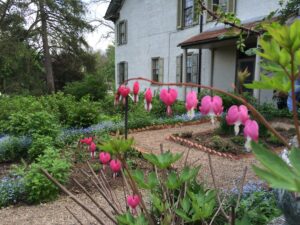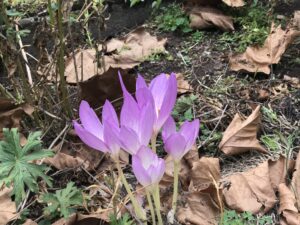The Centre Furnace Mansion Kitchen Garden has been a favorite garden feature of the Mansion’s grounds. The garden’s hardscaping has been in need of repair and improvement. This need is now urgent after necessary damage to the garden occurred as a result of the first phase of the Mansion’s restoration work. Estimated at $10,000, our goal is to be able to schedule these repairs and restore the Kitchen Garden during the 2023 season.
As we kick off raising funding for this project, we extend our great appreciation to donors:
Alex’s ProScape, LLC
Linda and David Witmer
Kitchen gardening is steeped in history. During the first half of the nineteenth century, the outbreak of Asian Cholera in the urban areas of America had a great impact on the way of life in rural America. As an alternative to unhealthy urban life, all of the positive aspects of gardening (a diet with plenty of fresh vegetables, physical exercise, spending time in the garden and country living) became the vision of the good life in America. Due to the lack of readily available fresh produce, it was designed to provide food for the four seasons, so plants were rotated and harvested at different times of the year. With such great dependence on the land and plants available, it is easy to see what a significant role the Kitchen Garden had in Victorian life. The kitchen garden was likely a primary source for vegetables, fruits, and culinary and medicinal herbs in the 19th century. The Thompson Family’s home was located far from a major city and services were limited. Necessity prompted the careful planning and maintenance of a “working garden”.
There is historic documentation of a large “truck garden” to the east of the Mansion during the Thompson era where produce was grown and sold. The word “truck” was used in a different way than we think of today. It was not a roadside stop, but rather part of the functioning larger Centre Furnace enterprise.
In the Victorian landscape design, inspired by Andrew Jackson Downing, the focus would have been on ornamental plantings and grassy areas. The practice was to shield the “working”, or functional areas from the public view. The Centre Furnace Mansion Kitchen Garden is located in an enclosed area on the north side of the home, and not visible from the main entrance or greeting areas. The location of the stone steps next to the Spring House, and their proximity to the new kitchen that the Thompsons added in 1846, suggests that a garden existed in that location.
The current Kitchen Garden at Centre Furnace Mansion is smaller than the typical vegetable/herb garden that would have likely have originally existed. When work on the Mansion restoration began, the garden, where we see it today, was an overgrown area. Some of it had been cemented over sometime between the 1920’s and 1975. There was a large Norway maple where the center of the garden is today.
Over the years, changes in plantings have been made to the Centre Furnace Mansion’s kitchen garden to more closely approximate what may have been used in the period of the Thompson’s residency, the mid to late 1800’s. The Kitchen Garden reminds visitors of the dependence the family had on the vegetables, flowers, and herbs that suited their respective needs.
The restoration of the kitchen garden and the areas surrounding it has become an evolving endeavor, which combines a shared interest in the garden of the past, with a goal to preserve, respect, and appreciate the kitchen garden for the future.
The kitchen garden, in its simplicity, stands as a tribute to the hard work of our Victorian ancestors. Amidst the stately trees and attractive flowerbeds, the kitchen garden contributes to the beauty of the grounds.
The gardens would not be possible without the vision and hard work of those who have been involved over the years.
Jim Deeslie, a Penn State landscape architect, who served on the Historical Society’s early garden committee, designed the foundation of the kitchen garden based on the location of the remains of an old stone wall. Louise Goldschmidt, another landscape architect, was the initial designer of the kitchen garden. Louise, Margery Johnstone, Barbara Miller and Marian Jones researched the design and contents of Victorian kitchen gardens for accuracy. Marian Jones, who worked in Penn State’s College of Science for nearly 50 years, planned, planted, weeded and tended the kitchen garden for more than a decade.
Beginning in 2000, a team of Master Gardeners and CCHS volunteers formed the Centre Furnace Mansion Garden Committee. The gardens have continued to develop and grow through the ongoing efforts, contributions and year-round planning of the Centre Furnace Mansion Gardeners . A number of community service groups and individuals also lend a much needed helping hand with the garden maintenance throughout the growing season.
The Spring House Garden graces the perimeter of the historic Spring House that is connected to the Centre Furnace Mansion and wraps around to the Kitchen Garden. This small garden hosts a variety of perennials giving the garden interesting colors and texture throughout the growing season.
Plant List – Kitchen Garden
Shrubs/Vines
- Chaste bush (Vitex agnus-castus)
- Black currant (Ribes nigrum)
- Clematis sp.
Perennials/Bulbs
- Anise hyssop (Agastache foeniculum)
- Bleeding heart (Dicentra spectabilis)
- Candytuft, common (Iberis sempervirens)?
- Chrysanthemum?
- Comfrey (Symphytum officinalis)
- Foxglove, yellow (Digitalis lutea)?
- Geranium x ‘Johnson’s Blue’
- Glory of the snow (Chionodoxa sp.)
- Goldenseal (Hydrastis canadensis)
- Hosta
- Obedient plant, white (Physostegia virginiana)
- Peony (Paeonia lactifolia)
- Primrose (Primula polyantha)
- Salvia?
- Sedum ‘Autumn Joy’ (Sedum telephium ‘Autumn Joy’
- Siberian bugloss (Brunnera macrophylla)
- Solomon’s seal (Polygonatum odoratum)
- Thyme, common (Thymus vulgaris)
- Virginia bluebells (Mertensia virginiana)
- Lily of the valley (Convallaria majalis)
- Germander (Teucrium chamaedrys)
- Lavender (Lavandula angustifolia)
- Great scarlet poppy (Papaver bracteatum)
- Feverfew (Tanacetum parthenium)
- Yellow fumitory (Corydalislutea)
- Asparagus (Asparagus officinalis)
- Rhubarb (Rheum rhabarbarum)
- Ostrich fern (Matteucciastruthiopteris)
- Houndstongue (Cynoglossum officinale)?
- Tulip (Tulipa bakeri ‘Lilac Wonder’)
- Garlic chives (Allium tuberosum)
- Phlox, mixed (Phlox paniculata)
- Rue (Ruta graveolens)
- Hollyhock (Alcea sp.)
- Oregano (Origanum vulgare)
- Valerian (Valeriana officinalis)
- Queen of the prairie (Filipendula rubra)
- Sage (Salvia officinalis)
- Horehound (Marrubium vulgare)
- Barrenwort (Epimedium sp.)
- Swamp milkweed (Asclepiasincarnata)
Annuals
- Larkspur (Consolida ajacis)
- Catchfly (Silene sp.)
- Pot marigold (Calendula officinalis)
- Forget-me-not (Myosotis sp.)
Plant List – Spring House Bed
Shrubs/Vines
- Rose ‘Stanwell Perpetual’
- Rose ‘Harrison’s Yellow’
- Clematis ‘Betty Corning’
- Pipevine (Aristolochia macrophylla)
- Rose ‘Charles de Mills’
Perennials/Bulbs
- Martagon lily (Lilium martagon)
- Wood poppy (Stylophorum diphyllum)
- Bleeding heart (Dicentra spectabilis)
- Mount Nittany iris (Iris germanica)
- Forget-me-nots (Mysotis scorpioides)
- Yellow waxbells (Uvularia grandiflora)?
- Lady bells (Adenophora confusa)
- Coral bells (Heuchera sanguinea)
- Sedum (assorted varieties)
- Moneywort (Lysimachia nummularia)
- Garden phlox (Phlox paniculata)
- Bloody cranesbill (Geranium sanguineum)
- White bleeding heart (Dicentra spectabilis ‘Alba’)
- Wall rock cress (Arabis caucasica)
- Hosta (mixed varieties)
- Creeping phlox (Phlox stolonifera)?
- Columbine, mixed varieties (Aquilegia hybrida)
- Toad lily (Trycertis hirta)?
- Black cohosh (Actaea racemose or Cimicifuga racemosa)
- Astilbe mixed
- Swamp milkweed (Asclepias incarnata)
- Primrose (Primiula X Hybrids)?
- Guinea hen flower (Fritallaria mealeagris)
- Great blue lobelia (Lobelia siphilitica)
- White lobelia (Lobelia siphilitica ‘Alba’)
- Yellow waxbells (Kirengishishoma palmata)
- Golden alexanders (Zizia aurea)
- Perennial ageratum (Conoclinium coelestinum or Eupatorium coelestinum)
- Garlic chives (Allium tuberosum)
- Clustered mountain mint (Pycnanthemum muticum)
- Double tiger lily (Lilium lancifolium ‘Flore Pleno’)
- Chrysanthemum, mixed
- Astilbe, mixed
- Daylily, mixed (Hemerocallis sp.)
Exhibit Building
Perennials/Bulbs
- St. John’s wort (Hypericum perforatum)
- Speedwell, blue (Veronica sp.)
- Anise hyssop (Agastache foeniculum)
- Swamp milkweed (Asclepias incarnata)
- Goldenrod (Solidago sp.)
- Comfrey (Symphytum officinalis)
- Tansy (Tanacetum vulgare)
- Feverfew (Tanacetum parthenium)
- Ostrich fern (Matteuccia struthiopteris)
- Black cohosh (Actaea racemose or Cimicifuga racemosa)
- Mint (Mentha sp.)
- Catmint (Nepeta sp.)
Annuals
- Pot marigold (Calendula officinalis)
- Verbena bonariensis









